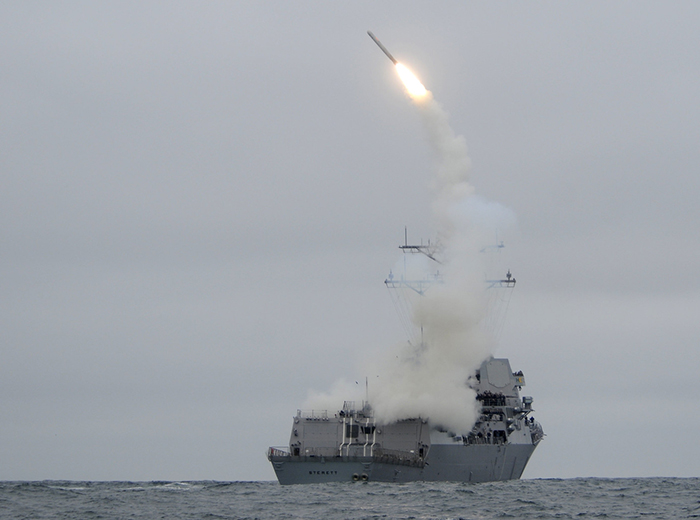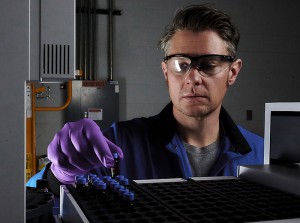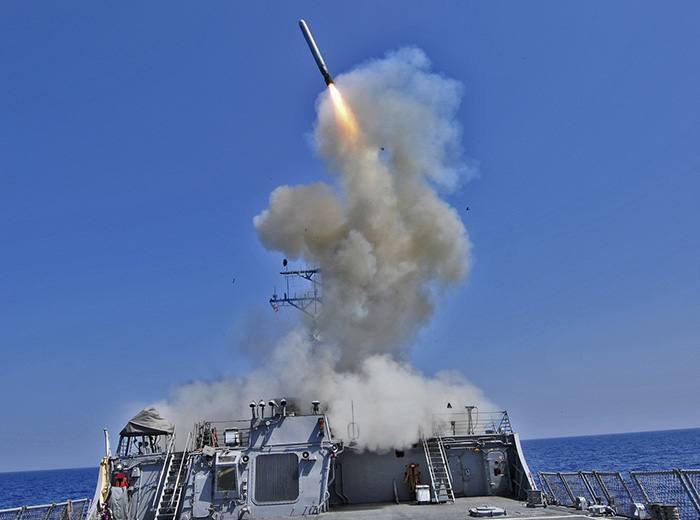
The U.S. Navy’s Tomahawks, which are long-range, all-weather cruise missiles, can instantly shift course mid-air, striking with GPS-enabled pinpoint accuracy. More than 2,300 Tomahawks have been used in combat, and they remain a critical part of modern U.S. defense. But in contrast to their performance reliability, the sourcing of Tomahawk fuel—called JP-10—is becoming more of a challenge.
Current JP-10 production methods rely on molecules derived from petroleum, which is a fossil fuel. To reduce American dependence on fossil fuels, the Department of Energy asked Los Alamos scientists to find an alternative JP-10 production process. Scientists took that challenge one step further by making the process greener and cleaner.

“We’ve patented a production process that makes JP-10 from domestic renewable feedstocks, such as corn bran,” says biomass conversion chemist Andrew Sutton, “which means we can make our own fuel from start to finish in the United States.”
The JP-10 produced from Sutton’s process performs the same as the JP-10 from petroleum-derived molecules. It’s the same product, but a better process—better because its production doesn’t require harsh acids, thereby generating significantly less chemical waste. In addition, the raw materials, because they’re biomass, are renewable, and their use in the new process boosts U.S. agriculture.
“Our process supports domestic jobs and simultaneously secures our nation,” says synthesis chemist Cameron Moore. “For example, producers of the domestic corn ethanol used in gasoline (up to 10 percent) can now use the byproducts of their process to make JP-10.” What was once a low-value byproduct of corn ethanol production can now be a high-value, profitable co-product. Sutton and Moore’s JP-10 production process is helping to diversify what was once a niche market.
And at the same time that the domestic economy will be bolstered by this alternative process, the cost of JP-10 may be significantly reduced, by about 50 percent, dropping the current price of $27.50 per gallon down to as low as $10.70 per gallon. So, our supply of Tomahawk fuel will be more reliable and more cost-effective.
Sutton’s success directly ties to JP-10’s future, in that once the cost per gallon of
JP-10 comes down enough, it can be considered for many more aviation applications. “Right now,” Sutton says, “JP-10 fuels Tomahawk cruise missiles, but it is being looked at as a potential high-energy-density jet fuel as well.”
This could be quite the tactical advantage for the U.S. military—energy-dense fuel means more bang for your buck, so jets won’t have to designate as much weight to fuel. This can translate to longer flights or more weapons carried.

Author
Katharine Coggeshall
Source
Los Alamos National Laboratory, press release, 2020-04-20.
Supplier
Los Alamos National Laboratory
US Navy
Share
Renewable Carbon News – Daily Newsletter
Subscribe to our daily email newsletter – the world's leading newsletter on renewable materials and chemicals










